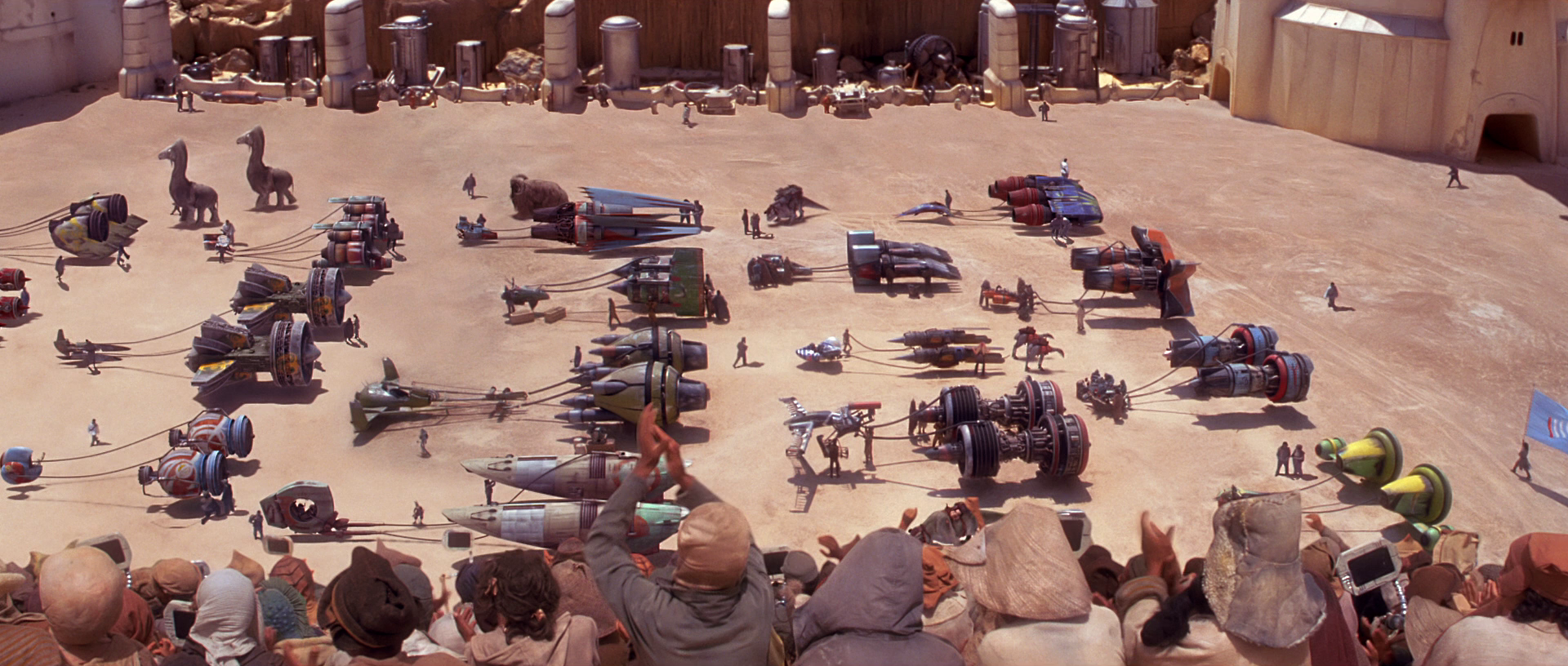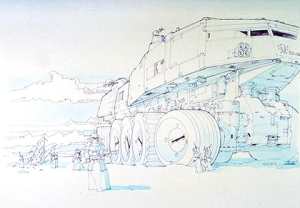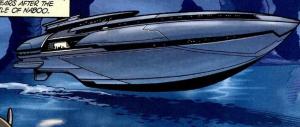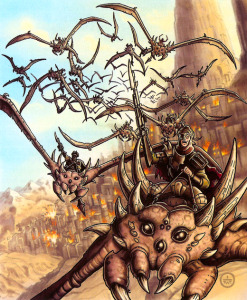
In Star Wars, even something as mundane as simply getting around is a visibly futuristic process. Cars are replaced with landspeeders that glide smoothly over even the roughest terrain without needing a single wheel to touch the nonexistent roads. Their governments must save a fortune on infrastructure upkeep. Skyhoppers and airspeeders are more like flying cars (or what flying cars would be like, if we had them) than planes, complete with being totaled by thrill-seeking young drivers.
A speeder bike is something like a motorcycle, only about a dozen times faster, with no wheels, and an even worse safety record when it comes to crashing headlong into inconvenient obstacles like trees. Crossing the great void between the stars to new worlds is as simple as booking passage on a vessel headed in the right direction, the galaxy’s denizens having long ago circumvented that troublesome little matter of the light barrier that’s been keeping us from our round trip to Alpha Centauri all these years.
With casual interstellar travel being so accessible to the general public, one can safely assume that travel time between cities or continents on the same world would be all but nonexistent in the vast majority of cases. War machines are regularly produced in bipedal and quadrupedal configurations and deployed to great effectiveness, despite the obvious limitations and weaknesses of the design. Clearly, someone has an extreme aversion to wheels and tank treads (to the disappointment of car chase enthusiasts everywhere).
It’s easy to dismiss these things as being nothing more than irrelevant bits of background information and lore; the means by which our heroes hop, skip, and jump between their interstellar adventures. Flavor for something that would be otherwise stale, of interest only to the most overzealous of pedants. In fact, nothing could be further from the truth.

Let’s take trains, for example. On the surface, perhaps the single most straightforward and least interesting form of transportation. It never deviates from its course, the entirety of its path and all stops are predetermined, and you have absolutely no control over any of it. Your only choice is where you get off. Under normal circumstances, hardly an exciting way to travel, even if the scenery is nice. But when it comes to Star Wars, abnormal is normal. I give you Murder on the Orient Express, or the Prequel-era comic referencing it The Aurorient Express. The Great Train Robbery. CSX 8888. That one mission in Jedi Academy where Coronet is nearly blown up by a train converted into a giant bomb.
And that’s just what you can do on a train. If we so wish, we can also extend them to link continents together instead of countries and cities, or provide a bridge from the surface to the stars. We can increase their speed until they rival aircraft for efficiency as methods of long-distance travel. We can encase them in armor and rig them with artillery until they qualify as a mobile fortress worthy of any intrepid hero’s attention. Or we could even abandon one of the core concepts of a train entirely and equip it with antigravity technology so that it no longer even requires a rail to run on (though, personally, I think that would take half the fun out of it).

But as ignored and neglected as trains have been in Star Wars, they still have it far better than seagoing vessels. With the exception of those works related to The Phantom Menace, they’ve been largely ignored in favor of their spacefaring counterparts (to whom the bulk of their terminology and mechanics have been transferred), receiving only a handful of passing mentions throughout most of the Expanded Universe. One could be forgiven for coming to the conclusion that conventional ships and boats are irrelevant in Star Wars. A completely absurd idea, of course. Piracy on the high seas remains as viable as piracy in space: just ask Nym. Or the Somalis, if you prefer an example somewhat closer to home.
Strategically-speaking, control of a world’s islands and seas can be equally vital as control of its major land masses, particularly if that world also happens to be inhabited primarily by aquatic species, such as the Mon Calamari or the Selkath. Or the Gungans. Lot of good your Star Destroyers and stormtroopers are doing to do against a planet where all the cities are underwater. In fact, some of the most creative and interesting episodes of The Clone Wars took place entirely underwater, though most of the more serious implications and challenges of fighting a pitched battle in such an unconventional environment were, of course, ignored.

Beasts of burden have always maintained a special place in the Star Wars universe, part of its particular futuristic neo-medieval charm. Luke Skywalker and Han Solo scouting on tauntaun mounts on Hoth in The Empire Strikes Back. Obi-Wan riding a giant lizard on Utapau in Revenge of the Sith. The Beast Riders of Onderon. With the exception of that last one, they’ve rarely been employed in any organized capacity. They just exist to fill out the background and add flavor to the environment. But what if you take that idea and run all the way with it? Let’s bring back cavalry. Entire battles were once waged on horseback, after all: and who needs horses when you have reeks, rancors, and rontos to ride?
It’s hardly unthinkable that there are situations in which they might still be employed. Just take Earth, for one example. Little more than a short flight separates any major city from parts of the world where oxen and camels still enjoy widespread use. Entire worlds have been established to operate at technological levels well below that of the rest of the galaxy: if the Ewoks can participate the Battle of Endor with sticks and stones, then there’s really no reason we can’t have some dragoons, lancers, and cuirassiers, too. War elephants were once fearsome weapons in the arsenals of many ancient armies: just think of what you could do with the kind of megafauna you find just lying around on worlds like Vendaxa or Dathomir.

Modern technology has vastly simplified the process of traveling great distances to faraway places, even when compared to times so recent as the first half of the previous century. It’s become such an integral part of our lives that our ability to carry out even the most mundane of tasks can be seriously impaired if our vehicles cease to function properly, to say nothing of the possibility of greater disasters. As such, it seems only appropriate that they might have a role to play in our fiction beyond merely shuttling our heroes from one plot point to the next. Different forms of transportation can provide us with interesting new ways of navigating alien worlds to which we might not be accustomed, while mechanical failure can cause all sorts of interesting complications.
Just look at the Millennium Falcon in The Empire Strikes Back. Had it worked properly, we’d never have ended up on Bespin, Luke would never have had to leave Dagobah, and a significant portion of Return of the Jedi might have been avoided entirely. A sufficiently large vehicle can provide a unique setting for self-contained stories set entirely within its walls, sabotage making even the most ordinary of space voyages potentially deadly for everyone onboard. Technology in Star Wars doesn’t always need to be about laser swords and deflector shields and starfighters: sometimes the potential for new stories can be found even in the most seemingly trivial places.
